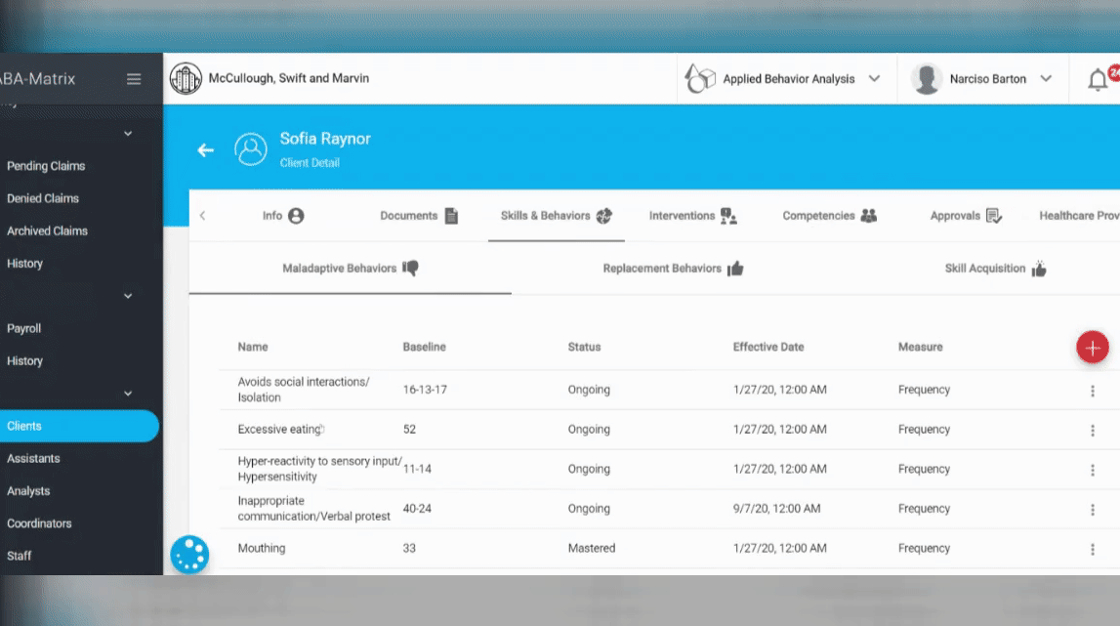How to add a new "Maladaptive Behavior"
This guide will teach you how to add a new "Maladaptive Behavior". It will show you step by step how to search for the desired client, add the new behavior, input relevant information, add short and long-term goals, save the information, and edit the behavior if necessary. If you need to add a new behavior to your management program, this guide will help you do so efficiently and effectively.
To insert a new "Maladaptive Behavior," access the program using an analyst or administrator account and proceed with the following steps.
Go to the Clients page
1. Click on the 'Clients' tab to open a window displaying a list of all clients.

Search for the desired client
2. Navigate to the search bar at the top right of your screen to look up the desired client. You may search using the client's name, Medicaid number, EQ Health number, caregiver's name, or phone number.

Go to the "Skills & Behaviors" tab
3. A screen displaying all the documentation and client information will appear. Navigate to the menu bar at the top of the screen and choose the "Skills and Behaviors" tab.

Select the "Maladaptive Behaviors" tab
4. Then, click on the "Maladaptive Behaviors" button, as shown in the image.

Add the new Maladaptive Behavior
5. Press the button represented by a "+" sign located in the top right corner of your screen.

Add the information for the Maladaptive Behavior
6. You will have access to a new window that is divided into 2 main parts:
- The initial section provides an overview of the "behavior."

7. - The second section of this document pertains to "Short Term Objectives" (STOs) and "Long Term Objectives" (LTOs).

8. Remember that all fields marked with asterisks (*) at the top must be filled in.

The behavior will become available starting from the effective date chosen in the Start Date field.
Short-Term Objectives (STOs) and Long-Term Objectives (LTOs)
9. To add a new "STO" or "LTO," press the "Add" button located on the right side of the screen. A small window will appear where you can enter all the information related to the "STO."
You have the option to set the start date, completion date, or expected completion date, if necessary.

10. You also have the possibility to specify the state in which the STO is and the effective date. The available statuses are:
- Pending: Marks the STOs that are waiting for implementation.
- Current: Indicates the active STO.
- Mastered: Designates objectives that have been successfully achieved.
- Discontinued: Indicates STOs that are no longer applicable or relevant.
These statuses offer better visibility into the progress of treatment plans and help you better monitor client outcomes over time.

11. Information about the new "STO" will be included in the bar called Description.

12. The LTOs are included in the same way as the STOs.

For improved functionality, first create the initial STO and LTO and save them. Then, duplicate the initial STO/LTO as many times as needed, and adjust the wording accordingly.
Save the information to add the behavior
13. After entering all the information, click the "Save" button to ensure the behavior is saved correctly.

A notification should appear at the top of the screen indicating that the "maladaptive behavior" has been successfully established.
List of Behaviors
14. You will find a list with all the maladaptive behaviors of the client.

15. Keep in mind that only seven behaviors can be displayed on one page. Should you add more than seven behaviors, the additional ones will be saved on a subsequent page, accessible by clicking the button in the bottom right corner of your screen. You can also change the amount of items per page.

Edit the Behavior
16. Once the behavior is created, you can edit and change its information. Just click on the behavior you want to modify, and you can do it from the tabs within the pop-up window:
- STOs/LTOs
- Measures
- Statuses
- Functions
- Topographies
- Intensities

Edit the STO/LTO
In the STO/LTO tab, you will have various editing options such as duplicate, edit, and delete.
17. Duplicate: You can duplicate the content of the STO if required.

Duplicating the initial STO you crafted and modifying the content of the duplicates can streamline the process of establishing a new behavior.
18. Delete: You can delete it.

19. Edit: Editing STOs/LTOs can be done through various methods:
- Adjust your order manually
- Change the name and description of STOs
- Change the status of the same
20. You can manually adjust the order of the STOs after they have been created. Click on the STO you want to move, then drag it to the position you want within the list. Release the mouse button to place the STO in its new position.

21. Users have the ability to personalize the names of the STOs to fit their individual requirements and tastes. To do this, simply click on the pencil icon next to the STO you wish to rename.

22. Click on the "Name" field to change the name of the STO and click on the "Description" field to change its description.

23. When you finish editing it click "SAVE".

